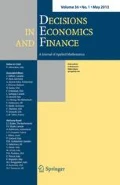It is often the case that, in complex contexts (and economics and finance are no exceptions), decisions must be analyzed and then made by carefully considering the alternatives with respect to several points of view. In this perspective, multi-criteria decision aiding (MCDA) supplies a set of concepts, theories, methodologies, and techniques to handle systematically these types of decisions. MCDA has been applied successfully in countless real-life problems in different domains, including economics and finance. The MCDA EURO Working Group (MCDA-EWG), in its 45 years of history characterized by two meetings each year, has been an important forum for the proposal and discussion of methodological contributions and real life applications permitting the development, of an original way of thinking in the theory and practice of MCDA. Within this community, the idea of this special issue found fertile ground and represents a follow up of the 89\(^{\mathrm{th}}\) meeting held in Trento, Italy. We are now happy to present six papers on methodological developments and real-world applications in the field of MCDA.
Anzilli and Giove (2020) present an application of the Choquet integral, a well-known aggregation function permitting to represent interaction between criteria on the basis of an underlying normalized monotone measure, to a multi-criteria problem stemming from health care. In particular, the Choquet integral is used to relate the risk of heart diseases to the patient’s scores with respect to three attributes, taking also into account their interdependencies. The authors also offer insights into the perspective of insurance policies.
The Choquet integral is also the focus of the paper by Bortot et al. (2020). This time the Choquet integral is coupled with De Groot’s model of consensual dynamic and a number of theoretical results and correspondences are established by the authors. In addition, the analysis of the results help shed light on the relation between Shapley and SuperShapley indices.
Brunelli and Cavallo (2020) study a number of rationality conditions for pairwise preference judgments and develop optimization problems to find the closest preferences satisfying such rationality conditions. They propose to use the distance as an estimation of the degree of violation of the rationality condition. On their way to studying these optimization problems, they provide a full set of inclusion relations between rationality conditions.
Within the same framework, Cavallo and D’Apuzzo (2020) investigate some rationality conditions for valued preference relations and study their implications on the stability and reliability of the obtained priorities.
Fedrizzi et al. (2020) consider the problem of the estimation of the violation of consistency, the strongest rationality condition, and analyzed a general method to estimate the inconsistency of preferences as their distance from the closest consistent ones. In particular, by using linear algebra, the authors show that a number of reasonable properties is satisfied if the distance is defined as a permutation-invariant norm of the difference between the matrix of the original preferences and the closest consistent approximation.
Di Caprio et al. (2020) integrate Data Envelopment Analysis (DEA) with fuzzy goal programming. Unlike the basic DEA, their new model can account for the preferences of decision makers and was tested on a real-life case study involving commercial banks.
References
Anzilli, L., Giove, S.: Multi-criteria and medical diagnosis for application to health insurance systems: a general approach through non-additive measures. Decis. Econ. Finance this issue (2020)
Bortot, S., Marques Pereira, R.A., Stamatopoulou, A.: Shapley and superShapley aggregation emerging from consensus dynamics in the multicriteria Choquet framework. Decis. Econ. Finance this issue (2020)
Brunelli, M., Cavallo, B.: Incoherence measures and relations between coherence conditions for pairwise comparisons. Decis. Econ. Finance this issue (2020)
Cavallo, B., D’Apuzzo, L.: Relations between coherence conditions and row orders in pairwise comparison matrices. Decis. Econ. Finance this issue (2020)
Di Caprio, D., Ebrahimnejad, A., Ghiyasi, M., Santos-Arteaga, F.J.: Integrating fuzzy goal programming and data envelopment analysis to incorporate preferred decision-maker targets in efficiency measurement. Decis. Econ. Finance this issue (2020)
Fedrizzi, M., Civolani, N., Critch, A.: Inconsistency evaluation in pairwise comparison using norm-based distances. Decis. Econ. Finance this issue (2020)
Author information
Authors and Affiliations
Corresponding author
Additional information
Publisher's Note
Springer Nature remains neutral with regard to jurisdictional claims in published maps and institutional affiliations.
Rights and permissions
About this article
Cite this article
Brunelli, M., Fedrizzi, M., Greco, S. et al. A special issue on multi-criteria decision aiding. Decisions Econ Finan 43, 557–558 (2020). https://doi.org/10.1007/s10203-020-00311-w
Accepted:
Published:
Issue Date:
DOI: https://doi.org/10.1007/s10203-020-00311-w

